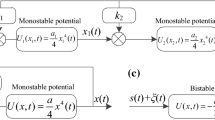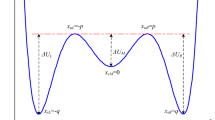Abstract
The theoretical method of stochastic resonance (SR) is helpful for the extraction of mechanical fault signals in the background of strong noise. Therefore, SR has been developed rapidly in the field of mechanical fault diagnosis. In the method of fault diagnosis based on SR, the under-damped tri-stable SR system shows its superiority in performance. However, the disadvantage of this model is that the potential function of the nonlinear system is not standardized enough, which brings inconvenience to the subsequent adjustment of system parameters. In order to solve this problem, this paper proposes a standard three-well underdamped stochastic resonance system. The steady-state probability density and output signal-to-noise ratio of the system are fully studied. Finally, a fault signal detection method based on the standard three-well underdamped stochastic resonance system is proposed, and the feasibility of this method in early fault diagnosis is proved by two different experimental platforms.




















Similar content being viewed by others
References
T. Liang, H. Lu, H.X. Sun, Entropy 23, 520 (2021)
T.X. Zhu, C.P. Zhang, G.B. Zhang, Shock. Vib. 1, 8899189 (2020)
R. Benzi, A. Sutera, A. Vulpiani, J. Phys. A: Math. Gen 14, L453 (1981)
A. Neiman, L. Schimansky-Geier, Phys. Lett. A 197, 379 (1995)
J.C. Tang, B.Q. Shi, Meas. Control 53, 788 (2020)
J.J. Liu, Y.G. Leng, Z.H. Lai et al., Acta. Phys. Sin. 65, 197 (2016)
G. Zhang, X. Wu, J. Electron. Meas. Instrum 33, 10 (2019)
L. Lu, Y. Yuan, C. Chen et al., Appl. Sci-Basel 10, 2602 (2020)
Y.F. Guo, Y.J. Shen, J.G. Tan, Mod. Phys. Lett. B 29, 1550034 (2015)
L. Lu, Y. Yuan, H. Wang et al., Symmetry-Basel 11, 965 (2019)
Y.C. Huang, C.K. Hu, Comput. Phys. Commun. 182, 249 (2011)
Y. Wang, S.B. Jiao, Q. Zhang et al., Chin. J. Phys. 56, 1187 (2018)
X.F. Zhang, N.Q. Hu, L. Hu et al., Sci. China Technol. Sci. 56, 2115 (2013)
D.Y. Han, P. Li, S.J. An et al., Mech. Syst. Signal. Pr. 70, 995 (2016)
J.M. Li, X.F. Chen, Z.J. He, J. Sound. Vib 332, 5999 (2018)
P.M. Shi, P. Li, S.J. An, Discrete. Dyn. Nat. Soc. 3, 1093562 (2016)
G. Zhang, Y.C. Shu, T.Q. Zhang, Mod. Phys. Lett. B 35, 2150219 (2021)
P.M. Shi, X. Su, D.Y. Han, Chin. J. Phys 55, 2124 (2017)
G. Zhang, Y.J. Zhang, T.Q. Zhang et al., IEEE. Access 6, 42431 (2018)
A. Silchenko, C.K. Hu, Phys. Rev. E 63, 041105 (2001)
G. Zhang, Y.L. Yang, T.Q. Zhang, Chin. J. Phys 60, 107 (2019)
L.F. He, C. Jiang, G. Zhang et al., Chin. J. Instrum 41, 226 (2020)
L.H. Wang, X.P. Zhao, Z.X. Zhou et al., Mod. Electron. Technol. 42, 40 (2019)
Z.X. Li, X.D. Liu, X. Wang et al., J. Sound. Vib. 459, 114862 (2019)
P.M. Shi, P. Li, S.J. An et al., Discrete Dyn. Nat. Soc 1, 2016 (2016)
C.B. He, P. Niu, R. Yang et al., Measurement 145, 687 (2019)
P.F. Xu, Y.F. Jin, Appl. Math. Model 77, 408 (2020)
N.Q. Hu, (National Defense Industry Press, 2012), pp. 16–25
G. Hu, (Shanghai Science Education Press, Shanghai, 1994), pp. 125–149
X. Liu, J. Vib. Eng 3, 88 (2006)
H.Y. Kuang, J. Jin, Y. Su, Comput. Eng. Appl 12, 97 (2006)
CWRU.drive end bearing fault data [EB/OL]. [2019-05-15] http://csegroups.case.edu/bearingdatacenter/pages/download-data-file.
G. Zhang, D.Y. Hu, T.Q. Zhang, IEEE Access 7, 58435 (2019)
J.Q. Feng, S.Y. Sun, Math. Study. Res. 3, 17 (2017)
B. Wang, Y.G. Lei, N.P. Li et al., IEEE. Trans. Reliab 69, 401 (2020)
Acknowledgements
This research is supported by the National Natural Science Foundation of China (No. 61771085), Research Project of Chongqing Educational Commission (KJ1600407, KJQN201900601). The authors also would like to thank the anonymous reviewers for their valuable comments and suggestions. They help us to improve the work comparatively and fundamentally.
Author information
Authors and Affiliations
Corresponding author
Ethics declarations
Conflict of interest
The authors declare that they have no known competing financial interests or personal relationships that could have appeared to influence the work reported in this paper.
Rights and permissions
About this article
Cite this article
He, L., Tan, C. & Zhang, G. Research on standard three-well stochastic resonance system and its application in early bearing fault diagnosis. Eur. Phys. J. Plus 136, 759 (2021). https://doi.org/10.1140/epjp/s13360-021-01741-0
Received:
Accepted:
Published:
DOI: https://doi.org/10.1140/epjp/s13360-021-01741-0




